State of the Australian Wine Industry in 2023 Following Chinese Tariffs

The China-Australia Free Trade Agreement (ChAFTA), which came into effect on December 20, 2015, played a significant role in promoting trade between the two countries, particularly in the wine industry. Under the ChAFTA, the tariff on Australian wine imports to China gradually decreased, ultimately reaching zero percent in Jan-19. In contrast, countries without a Free Trade Agreement (FTA) with China face a tariff of 14% on bottled wine imports (less than 2 liters) and 20% on bulk wine imports (more than 2 liters). This tariff advantage has improved the competitiveness of Australian wine in the Chinese market and boosted overall sales to China. Resultantly, Australian wine exports to China increased from 62.27 million liters worth USD 213.54 million (AUD 325.56 million) in the 12 months ending Oct-15 to 120.81 million liters worth USD 825.93 million (AUD 1.26 billion) in the 12 months ending Oct-20 as illustrated in Figure 1.
Figure 1. Australian Wine Export Volume and Value 2011 to 2023
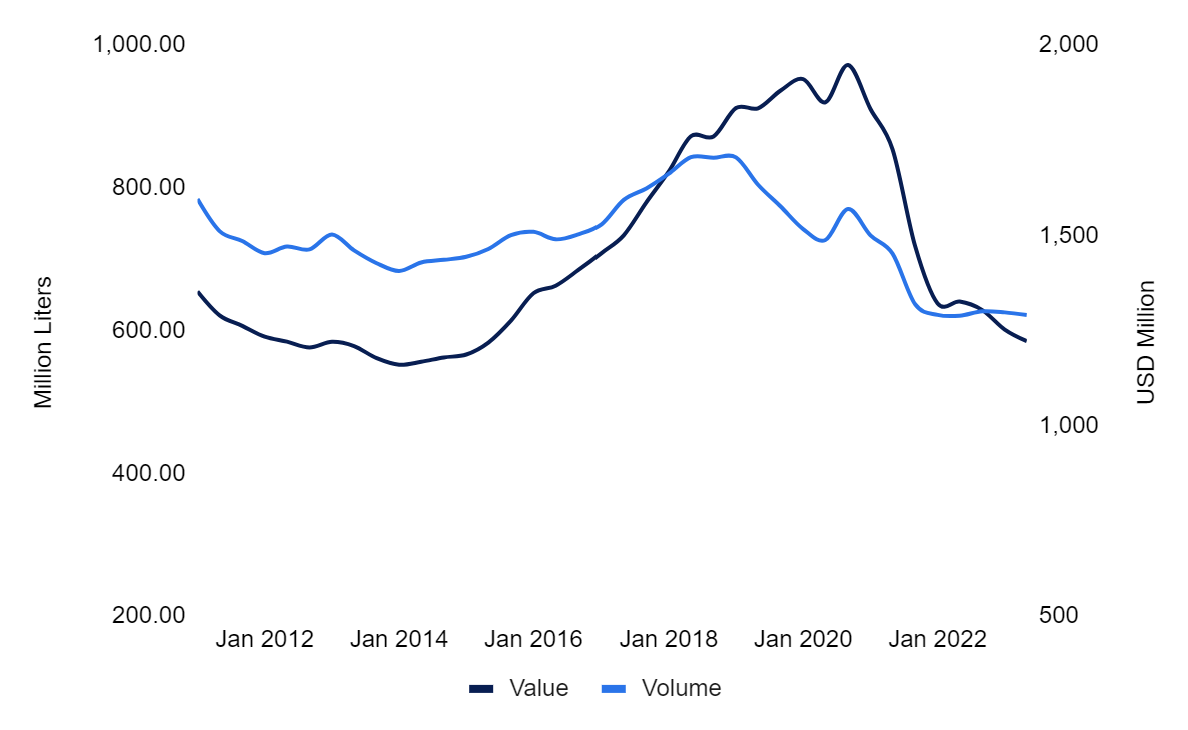
Source: Wine Australia
In Oct-15, China accounted for 8.48% of Australian wine exports in terms of volume and 16.39% in terms of value, with the average value of a liter of wine at USD 3.43 (AUD 5.23). Five years later, in the 12 months ending Oct-20, wine exports to China accounted for 15.70% of Australian wine exports in terms of volume and 40.97% in terms of value. During this five-year period under the ChAFTA, China became by far the largest market for Australian wine exports, equal in value to the next five largest export destinations combined - the United Kingdom (UK), the United States (US), Canada, New Zealand, and Hong Kong. In total, Australian wine exports increased from USD 1.30 billion (AUD 1.97 billion) in Oct-15 to USD 2.02 billion (AUD 3.07 billion) in Oct-20, primarily driven by strong demand in China for Australian bottled wine.
However, Australia’s wine export situation drastically changed towards the end of 2020. The political relationship between Australia and China deteriorated after the Australian Prime Minister at the time, Scott Morrison, called for an independent investigation into the origins and spread of COVID-19. In retaliation, the Chinese Ministry of Commerce (MOFCOM) initiated an anti-dumping (AD) investigation on August 18, 2020, and a countervailing duties (CD) investigation on August 31, 2020, explicitly targeting Australian wine in the Chinese market. Subsequently, MOFCOM decided to impose temporary deposit tariffs ranging from 107.1% to 212.1% on November 28, 2020, on Australian wine in containers of up to 2 liters, ahead of finalizing the ongoing anti-dumping investigation.
On March 26, 2021, MOFCOM confirmed that temporary deposit tariffs of between 116.2% and 218.4% on Australian wine in containers of up to 2 liters would remain in place for five years. However, Australian fortified and bulk wines were exempted. These anti-dumping duties made Australian wine significantly less competitive in the Chinese market and severely constrained Australian wine exports to China. This situation made the Chinese wine market economically unfeasible in the short term for Australia. This had immediate and severe consequences for the Australian wine industry, as illustrated in Figure 2.
Figure 2. Australian Wine Export Value to China Versus Rest of the World
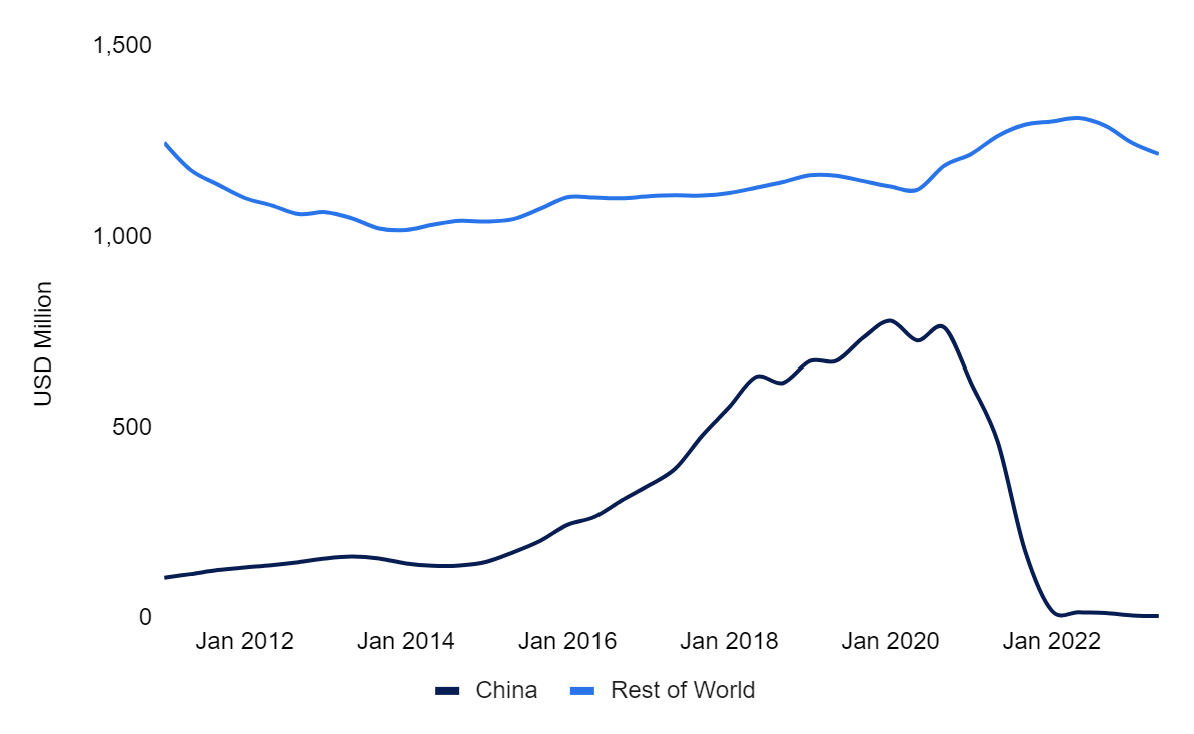
Source: Wine Australia
Australian wine exports to China plummeted by 99% from its peak of 120.81 million liters of wine worth USD 825.93 million (AUD 1.26 billion) in the 12 months ending Oct-20 to only USD 5.3 million (AUD 8.1 million) in the 12 months ending Jun-23. This drop left a significant gap in Australia’s wine exports, creating an overnight oversupply and negatively affecting export prices. Australia’s overall wine exports dropped from its peak of USD 2.02 billion (AUD 3.07 billion) in Oct-20 to USD 1.22 billion (AUD 1.87 billion) in Jun-23, with the average value of a liter of wine destined for an export market decreasing from USD 2.61 (AUD 3.99) to USD 1.96 (AUD 3.00) during this period.
Figure 3. Australian Wine Export Volume to China Versus Rest of the World
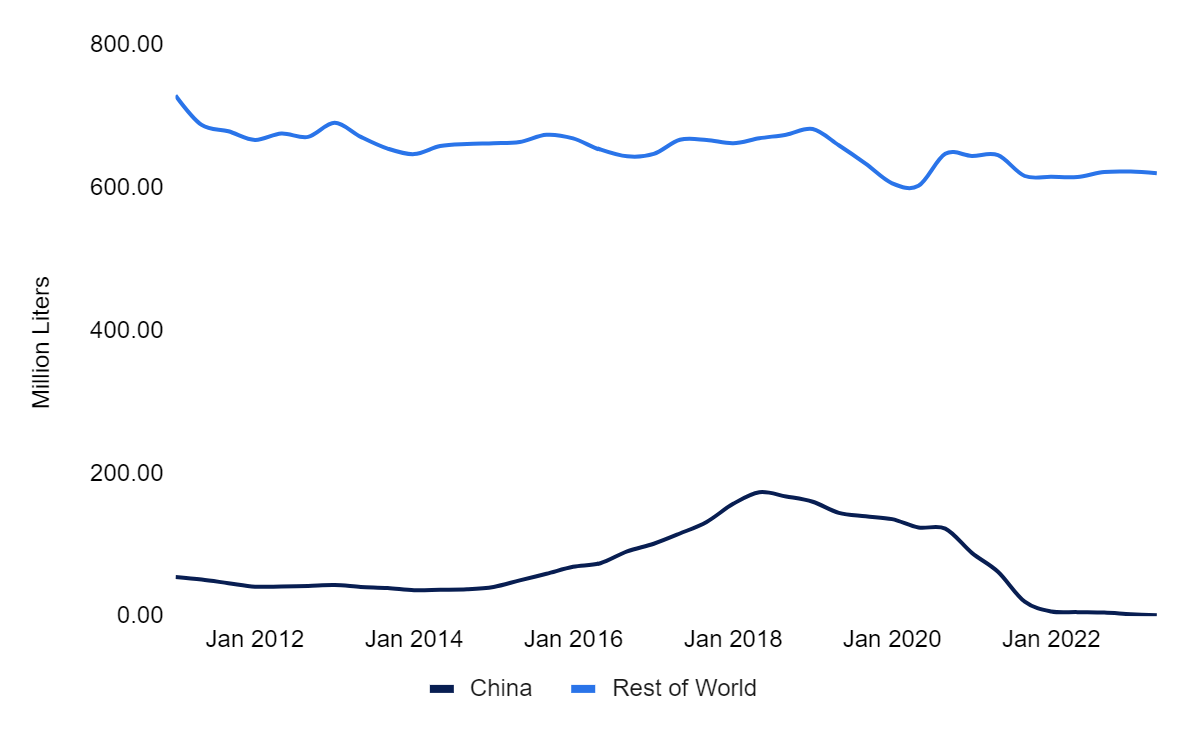
Source: Wine Australia
Amid this decline, Australia needed to further develop existing markets and diversify into new markets in an effort to fill the ever-increasing gap left by China. However, Australia simultaneously also experienced declines in exports to its next three largest markets - the US, the UK, and the rest of Europe - primarily due to economic difficulties and declines in wine consumption in these regions. However, Australia did manage to increase exports to Hong Kong and Singapore in recent years due to their status as trade hubs in the Asian region.
Australian wine exports to Hong Kong and Singapore experienced significant growth between 2020 and 2021. For the year ending Jun-21, exports to Hong Kong increased by 110.70% from USD 57.87 million (AUD 88.52 million) to USD 121.94 million (AUD 186.50 million). In the following six months, exports to Singapore increased by 108.35% from USD 52.07 million (AUD 79.64 million) to USD 108.49 million (AUD 165.93 million) for the year ending Dec-21. This growth has tapered off until the present day for Singapore for the year ending Jun-23 at USD 83.30 million (AUD 128.60 million) but has remained high and growing for Hong Kong at USD 143.91 million (AUD 219.86 million) during the same period. This growth has resulted in Hong Kong becoming the second-largest and Singapore the fifth-largest wine export market for Australian wine.
Figure 4. Australian Wine Export Value to Hong Kong and Singapore
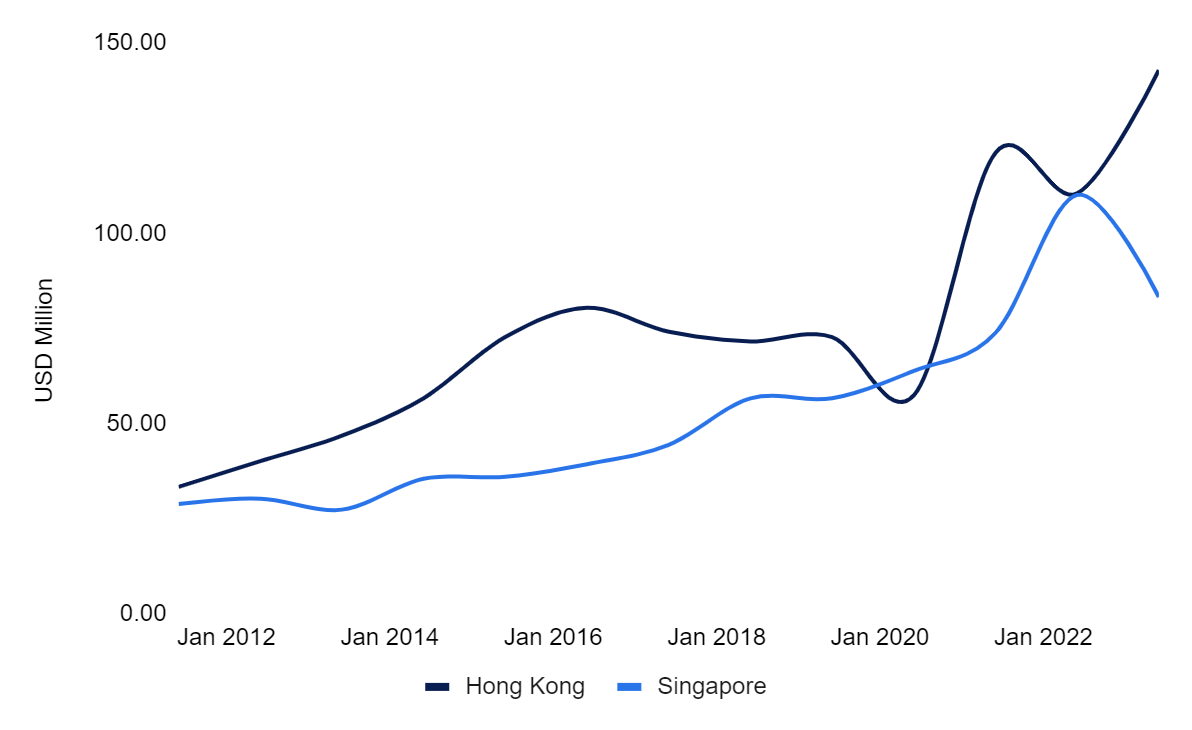
Source: Wine Australia
Diversification into emerging markets, where the wine category is still in its infancy, has also been rising, particularly in the rest of Asia. Most notably, between Jun-20 and Jun-23, exports to Thailand increased 226.24% to USD 37.46 million, Malaysia to USD 32.80 million (+62.76%), South Korea to USD 24.51 million (+77.30%), Taiwan to USD 16.00 million (+22.88%), the Philippines to USD 10.96 million (+40.50%), India to USD 7.05 million (+46.01%), and Vietnam to USD 6.18 million (+106.95%). These gains come nowhere close to filling the gap left by the Chinese market but provided diversification options to Australian exports and markets to explore and grow into the future.
Figure 5. Australian Wine Export Value to Other Asian Markets
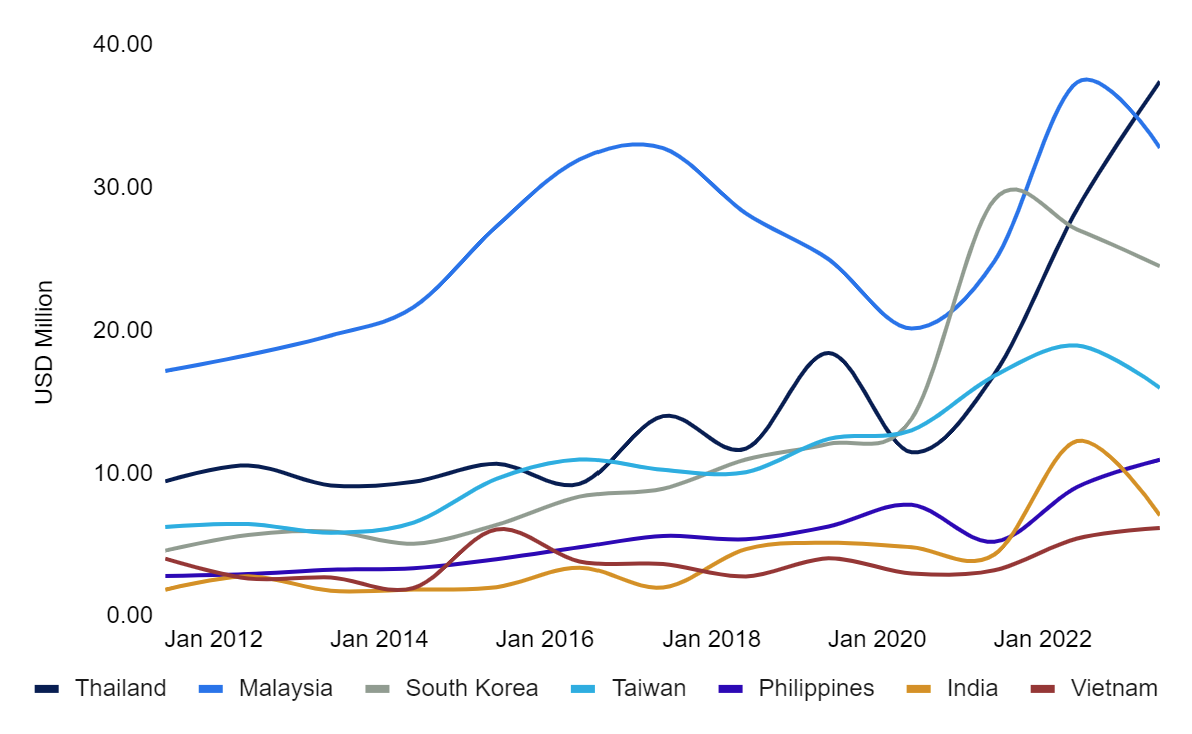
Source: Wine Australia
The only way for the Australian wine industry to return to its pre-China tariff export levels is to restore diplomatic ties with China. Rumors continue to circulate regarding the potential re-opening of the wine trade corridors between Australia and China, with most stakeholders hoping for good news before the end of 2023. For the first time since 2019, a meeting between Australia’s Minister for Agriculture, Fisheries & Forestry, Murray Watt, and Tang Renjian, China’s Minister of Agriculture & Rural Affairs, has taken place in Rome – another step towards stabilizing the relationship between the two countries. This comes after China lifted the bans on coal and timber imports from Australia earlier in 2023 and is expected to lift barley import tariffs in the second half of 2023.


